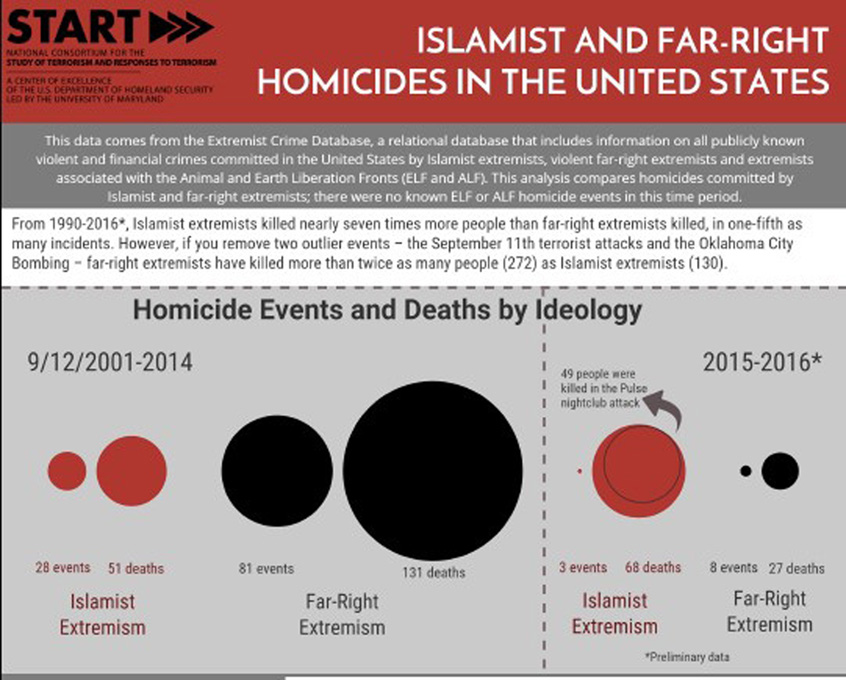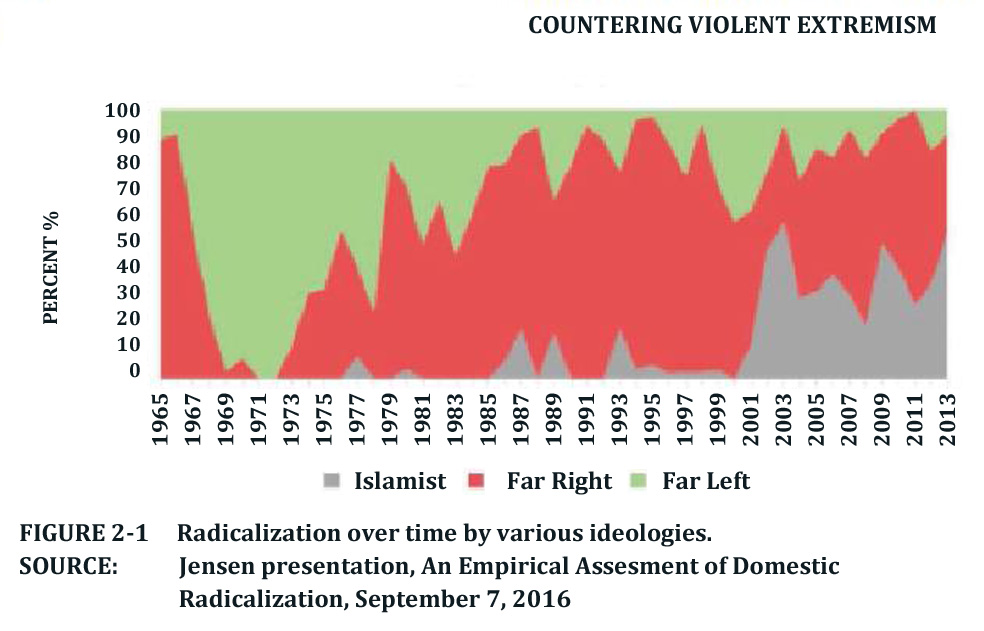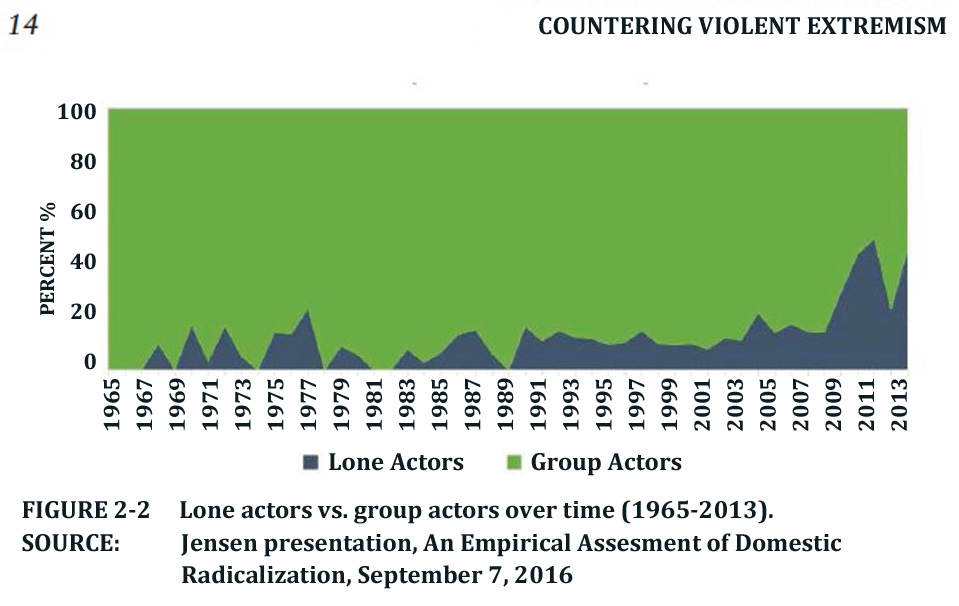Stopping At START
by Carol Sebastian (August 2017)

Last September 7-8, in Washington DC, a meeting of public health agencies, government, and preparedness organizations met to discuss how to counter “violent extremism.” Content from the “Countering Violent Extremism” workshop demonstrates how the threat of Islamism is minimized by experts studying terrorism, and producing educational materials on it, for the U.S. government.
Dr. Michael Jensen, a senior researcher representing START (National Consortium for the Study of Terrorism and Responses to Terrorism) presented statistics and analysis on violent extremism at the Washington conference. START is contracted by the Department of Homeland Security to provide research and education, and maintains the PIRUS (Profiles of Individual Radicalization in the United States) database.
START’s website contends that right-wing extremists are a larger problem than Islamists. The 2016 conference instructed attendees that “countering violent extremism” programs disproportionately address “one end of the spectrum” but that the real threat is “far right wing and white supremacists’ groups.”
To support its thesis, START published a comparison of terror incidents and deaths by Islamists and far-right extremists—using the period September 12, 2001 to December 31, 2014. START’s chart (printed below) characterizes the Islamist terrorist 9/11 attacks (2,996 deaths) and the far-right terrorist Oklahoma City bombing (168 deaths) as “outlier events,” and they are therefore omitted. START’s outliers vary considerably as to numbers murdered; the 9/11 attack killed nearly 18 persons for every one killed by the Oklahoma City bombing.

START’s figures show total far-right extremist deaths totaling 158 from September 12 (9/11 victims are not included) 2001-2016. During that period Islamists were, according to the START figures, responsible for 119 deaths—three-quarters as many people as the far-right extremists. START’s preliminary data has Islamists responsible for more terror deaths than the far-right in 2015-2016. Yet START asks us to view the main threat as right-wing extremists.
Though he is concerned that attention to Islamism is disproportionate, Dr. Jensen presented the chart below at the workshop. The Islamist “radicalization over time” (grey segment of the graph) has expanded over time to become about half, and the far-right extremists (red area) diminishes a bit over time.

The chart shows that a spike in Islamism followed the 9/11 attacks, and that spike has never returned to baseline. During the Obama Administration, Islamist radicalization in the U.S. rose to levels nearly as high in the period just after 9/11. In 2013, Muslims, comprising 1% of the US population, represented an astounding one-half of those “radicalized over time” in 2013. The “one end of the spectrum” of Islamists receives too little attention.
How Much Attention Should be Given to Islamist Terrorists?
Islamist terrorism deserves a lion’s share of attention from law enforcement. Security expenses connected with Islamism, such as airport security, costs the U.S. billions of dollars annually; the huge hidden expense of time and productivity lost is significant.
Placing the highest priority on the most lethal threat is sensible. START estimates Islamist terror-caused deaths as more than double those attributed to far-right radicals in 2015-16. Focusing on far-right radicals rather than the growing threat of radicalized Islamists is poor use of limited resources.
Can START Develop a Profile for Islamist Terrorists in the U.S.?
Last September’s workshop consensus was that there is no reliable profile for radicalized extremists. START has studied nearly 1,500 terrorists and aggregated its findings in the PIRUS database. Dr. Jensen’s talk presented PIRUS data sorted by terrorist’s ideology (far-left, far-right, and Islamist).
PIRUS DATA ON EDUCATIONAL LEVEL OF TERRORISTS BY IDEOLOGICAL GROUP
Table 1. Dr. Michael Jensen’s data presented at “Countering Violent Extremism Through Public Health Practice”,
9/7 – 9/8/17. Data placed in table by writer.
|
Type of Violent Extremists |
Extremists With College Experience |
|
Far Right |
45% |
|
Far Left |
75% |
|
Islamists |
59% |
PIRUS data refutes the notion that Islamic extremists come from impoverished, poorly educated backgrounds. Despite the 2015 statements by a U.S. Department of State spokeswoman that lack of economic opportunity explains why “17-year-old kids pick up an AK-47 instead of starting a business,” a majority are economically and socially successful enough to attend college. Islamist terrorists are more likely than far-right terrorists to have some college education. This reflects a worldwide reality: al-Baghdadi, the “Caliph” of ISIS earned a PhD in Islamic studies, and several 9/11 terrorists were students.
PIRUS DATA ON PREVIOUS CRIMINAL BEHAVIOR IN TERRORISTS
Table 2. Dr. Michael Jensen’s data presented at “Countering Violent Extremism Through Public Health Practice”,
9/7 – 9/8/16. Data placed in table by writer.
|
Type of Violent Extremists |
History of Criminal Behavior Prior to Radicalizing |
Likelihood to Commit Violence After Radicalizing |
| Far Right |
63% |
2-3 times more likely than leftists |
| Far Left |
51% |
Less likely than far-right or Islamists |
| Islamists |
40% |
2-3 times more likely than leftists |
A history of criminal behavior relates strongly to Islamist radicalization. How many young men convert to Islam in prison, influenced by radical imams, and then commit jihad atrocities after release? Do some Muslims become pious in prison, and then embrace jihad?
LONE ACTORS (“LONE WOLVES”) — START DATA

The PIRUS database finds that lone wolf or “lone actor” terrorists have become more prevalent over time. Most recent Islamic jihad attacks in the U.S. are reported by media as acts committed by “lone wolves.” The PIRUS database, however, considers “lone actors” to be only 9% of all terrorists.
The 2016 conference described most lone actors as “deeply embedded in strong social networks and thus not alone in a practical sense,” and true lone actors, who “have no interaction with anyone else with extreme views—are the outlier, not the norm.”
The 2016 conference noted that radicalization through social media means that lone wolf terrorists are not truly solitary, but receive encouragement to commit jihad atrocities from other Islamists in their social support network of family and community, and through social media contacts and Islamist websites. They are not “lone” in the traditional sense, but are individuals who act upon the imperative of jihad, often with the fore- knowledge of their community.
A prominent example of online radicalization is Nidal Hasan, the Ft. Hood jihadist, who established regular online contacts with Anwar al-Awlaki, an American imam relocated to Yemen. Online contacts leading to radicalization in less than one year are becoming more common.
Can we use START Data to Develop a Profile for Islamists Terrorists?
What information do we have that is useful for acting to reduce the threat of Islamism? There is at least a partial profile for Islamists. The most common characteristics of a violent extremist Islamist, according to PIRUS, is (1) a young male Muslim or male Muslim convert in his late teens or 20s, who often (2) has had some college education. A substantial minority has (3) a history of criminal behavior; and is (4) embedded in a radical social network, which often consists of social media contacts.
Acting on the PIRUS Findings on Terrorist Characteristics
First, any persons who encourage Muslims to behave as Mohammed did, that is to commit violent jihad, must be prosecuted. The social network of Muslims who commit jihad must be held accountable, when those in these networks fail to contact authorities when radicalization, and potential jihad atrocities, are likely to occur.
Because a substantial number of Islamist radicals have a history of criminal behavior, management of jails and prisons must be addressed. Due to the difficulty of accrediting Muslim chaplains to assure that they won’t preach jihad to inmates, all contacts of imams and inmates must be conducted in English only, and supervised by prison personnel. Inmates whose behaviors indicate an interest in violent jihad must be closely monitored when released.
The radical social network, including the family and mosque, must be addressed. Mosques use their status as religious organizations in the U.S. as protection from scrutiny. The least that should be done to respond to radical, mainly Saudi-sponsored mosques is to thoroughly investigate mosques associated with terrorist acts. Imams must be held to account for their sermons, when they encourage violence resulting in deaths and injuries.
Islamism
Any form is Islamism is a threat to the United States. Islamic law is utterly incompatible with U.S. law, U.S. Constitution, and Bill of Rights. Some examples of incompatibility of sharia law with U.S. law includes the cruel and unusual punishments of amputation, beheading, and stoning, treating Muslims and non-Muslims significantly differently, treating men substantially better than women, and lack of freedom of speech and conscience (blasphemy and apostasy laws).
Is START a non-STARTer?
START has collected valuable data, but START’s analysis of its findings doesn’t match the data. START does categorize Muslim terrorists as “Islamists,” a more realistic designation of terrorists’ motivation. But, the START approach appears to concern itself with Islamists only if they plot or commit violence.
1% of the U.S. population (Islamists) hold views that are inimical to U.S. law. Focusing on that 1% to get a better handle on half of the domestic radicalization problem should be a priority; let’s start on that and use the information we already have to more effectively secure our homeland.
_________________________________
Carol Sebastian is a nurse at a midwestern hospital. She enjoys gardening, reading, writing, teaching Sunday School, and caring for her greyhound.
To help New English Review continue to publish interesting articles, please click here.